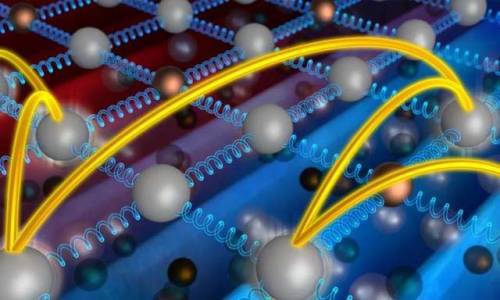#insulators
New insights bolster Einstein’s idea about how heat moves through solids
A discovery by scientists at the Department of Energy’s Oak Ridge National Laboratory supports a century-old theory by Albert Einstein that explains how heat moves through everything from travel mugs to engine parts.
The transfer of heat is fundamental to all materials. This new research, published in the journal Science, explored thermal insulators, which are materials that block transmission of heat.
“We saw evidence for what Einstein first proposed in 1911—that heat energy hops randomly from atom to atom in thermal insulators,” said Lucas Lindsay, materials theorist at ORNL. “The hopping is in addition to the normal heat flow through the collective vibration of atoms.”
The random energy hopping is not noticeable in materials that conduct heat well, like copper on the bottom of saucepans during cooking, but may be detectable in solids that are less able to transmit heat.
Post link
Chameleon-Like Material Spiked With Boron Helps Bring Brain-Like Computing to Silicon Chips
Chameleon-Like Material Spiked With Boron Comes Closer To Mimicking Brain Cells
In a new study, Texas A&M researchers in the Department of Materials Science and Engineering describe a new material that comes close to mimicking how brain cells perform computations.
Each waking moment, our brain processes a massive amount of data to make sense of the outside world. By imitating the way the human brain solves everyday problems, neuromorphic systems have tremendous potential to revolutionize big data analysis and pattern recognition problems that are a struggle for current digital technologies.
But for artificial systems to be more brain-like, they need to replicate how nerve cells communicate at their terminals, called the synapses.
Post link
Aberrant electronic and structural alterations in pressure-tuned perovskite
The perovskite NaOsO3 has a complicated but interesting temperature-dependent metal-insulator transition (MIT). A team led by Drs. Raimundas Sereika and Yang Ding from the Center for High Pressure Science and Technology Advanced Research (HPSTAR) showed that the insulating ground state in NaOsO3 can be preserved up to at least 35 GPa with a sluggish MIT reduction from 410 K to a near room temperature and possible transformation to a polar phase. The work has been published in npj Quantum Materials.
NaOsO3 perovskite undergoes a metal-insulator transition concomitant with the onset of an antiferromagnetic long-range ordering at a Neel temperature of about 410 K, which is accompanied by a magnetic ordering without any lattice distortion.
The team carried out a combined experimental and computational study to understand the effect of external pressure on perovskite NaOsO3. They found hidden hysteretic resistance properties with a transient metallic state near 200 K. Also three electronic character anomalies (at 1.7, 9.0, and 25.5 GPa), and a structural transition to the singular polar phase (at ~ 18 GPa) were discovered.
Post link
.
from the 2017/2018 one-a-day series
038 outtake/ 365+ . porcelain . 07february2017
.
#tbt #sculpture #foundobjects #balance #prop #stack #insulators #porcelain #rust #pnw #maplereach #480perches #tualatindrainage #oregon #oneaday
https://www.instagram.com/p/B8O1QkllwwC/?igshid=1lvdnhnlkeekj
Post link




